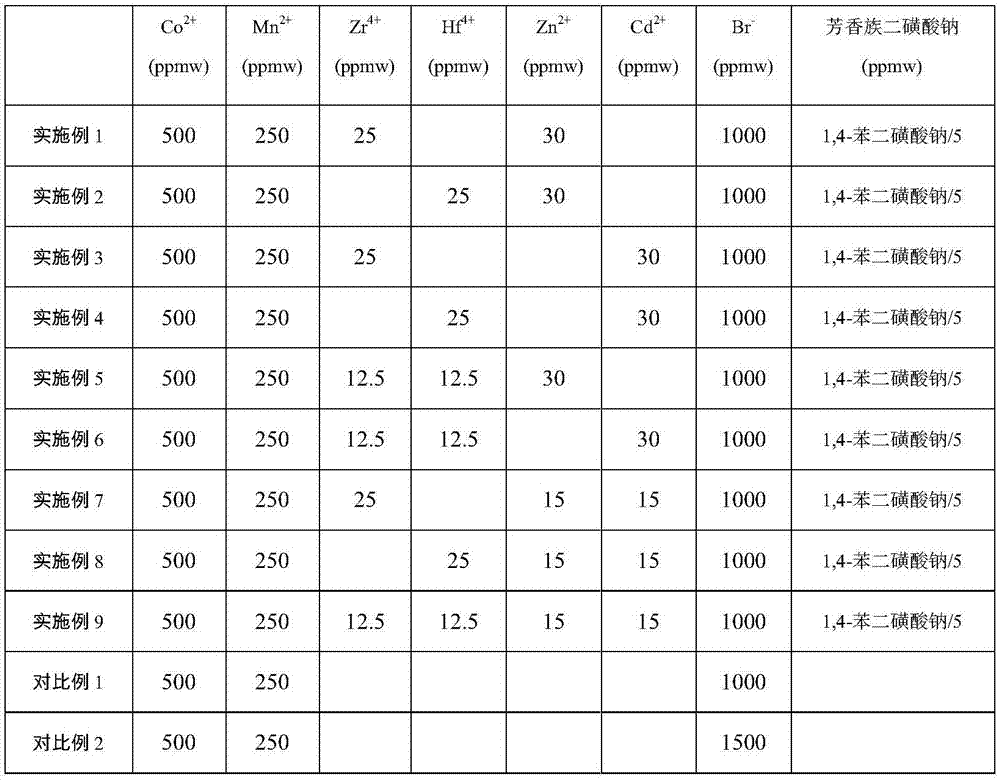Catalyst for preparing aromatic polycarboxylic acid
A technology of catalyst and polycarboxylic acid, which is applied in the direction of physical/chemical process catalyst, carboxylate preparation, metal/metal oxide/metal hydroxide catalyst, etc. It can solve the problems of low bromine consumption, high bromine content and low impurity content And other issues
- Summary
- Abstract
- Description
- Claims
- Application Information
AI Technical Summary
Problems solved by technology
Method used
Image
Examples
Embodiment 1
[0037] The reaction was carried out in a 1000ml titanium autoclave equipped with a magnetic stirrer, a gas delivery pipe, a reflux condenser, a thermocouple, and a bursting disc, with a stirring speed of 400rpm and heated by circulating hot oil. The reaction steps are as follows:
[0038] 1) Mix 80g p-xylene, 400g acetic acid and 20g catalyst acetic acid solution (containing cobalt acetate, manganese acetate, zirconium acetate, zinc acetate, 1,1,2,2-tetrabromoethane, 1,4-benzenedisulfonic acid Sodium) is added into autoclave after mixing evenly, and airtight; Wherein by weight of the mixture, containing 500ppmw Co 2+ 、250ppmw Mn 2+ , 25ppmw Zr 4+ , 30ppmw Zn 2+ , 1000ppmw bromine and 5ppmw 1,4-benzenedisulfonate sodium.
[0039] 2) Add 2.0MPa nitrogen to carry out the airtight test for 30 minutes, and the pressure drop within 30 minutes is not more than 0.1MPa, which is qualified.
[0040] 3) Add nitrogen, the mass space velocity is 4h -1 , and start the stirrer, the sti...
Embodiment 2
[0045] The reaction was carried out in a 1000ml titanium autoclave equipped with a magnetic stirrer, a gas delivery pipe, a reflux condenser, a thermocouple, and a bursting disc, with a stirring speed of 400rpm and heated by circulating hot oil. The reaction steps are as follows:
[0046]1) Mix 80g p-xylene, 400g acetic acid and 20g catalyst acetic acid solution (containing cobalt acetate, manganese acetate, hafnium acetate, zinc acetate, 1,1,2,2-tetrabromoethane, 1,4-benzenedisulfonic acid Sodium) is added into autoclave after mixing evenly, and airtight; Wherein by weight of the mixture, containing 500ppmw Co 2+ 、250ppmw Mn 2+ 、25ppmw Hf 4+ , 30ppmw Zn 2+ , 1000ppmw bromine and 5ppmw 1,4-benzenedisulfonate sodium.
[0047] 2) Add 2.0MPa nitrogen to carry out the airtight test for 30 minutes, and the pressure drop within 30 minutes is not more than 0.1MPa, which is qualified.
[0048] 3) Add nitrogen, the mass space velocity is 4h -1 , and start the stirrer, the stirrin...
Embodiment 3
[0053] The reaction was carried out in a 1000ml titanium autoclave equipped with a magnetic stirrer, a gas delivery pipe, a reflux condenser, a thermocouple, and a bursting disc, with a stirring speed of 400rpm and heated by circulating hot oil. The reaction steps are as follows:
[0054] 1) Mix 80g p-xylene, 400g acetic acid and 20g catalyst acetic acid solution (containing cobalt acetate, manganese acetate, zirconium acetate, cadmium acetate, 1,1,2,2-tetrabromoethane, 1,4-benzenedisulfonic acid Sodium) is added into autoclave after mixing evenly, and airtight; Wherein by weight of the mixture, containing 500ppmw Co 2+ 、250ppmw Mn 2+ , 25ppmw Zr 4+ 、30ppmw Cd 2+ , 1000ppmw bromine and 5ppmw 1,4-benzenedisulfonate sodium.
[0055] 2) Add 2.0MPa nitrogen to carry out the airtight test for 30 minutes, and the pressure drop within 30 minutes is not more than 0.1MPa, which is qualified.
[0056] 3) Add nitrogen, the mass space velocity is 4h -1 , and start the stirrer, the s...
PUM
 Login to View More
Login to View More Abstract
Description
Claims
Application Information
 Login to View More
Login to View More - R&D
- Intellectual Property
- Life Sciences
- Materials
- Tech Scout
- Unparalleled Data Quality
- Higher Quality Content
- 60% Fewer Hallucinations
Browse by: Latest US Patents, China's latest patents, Technical Efficacy Thesaurus, Application Domain, Technology Topic, Popular Technical Reports.
© 2025 PatSnap. All rights reserved.Legal|Privacy policy|Modern Slavery Act Transparency Statement|Sitemap|About US| Contact US: help@patsnap.com



